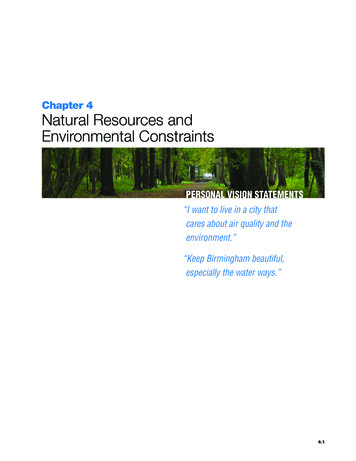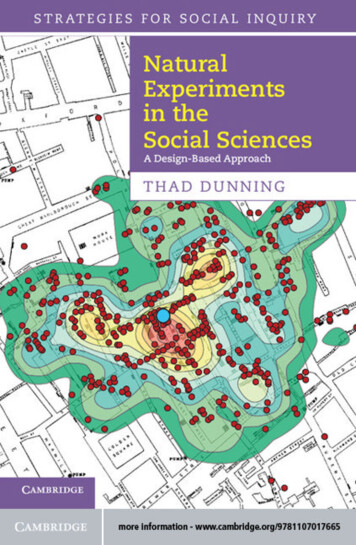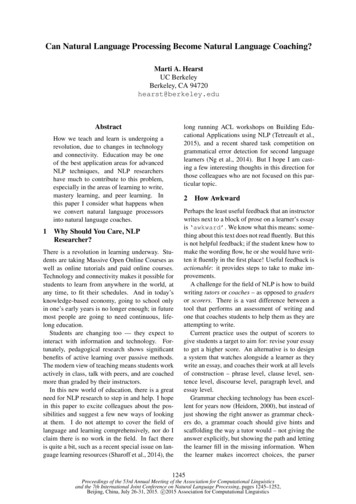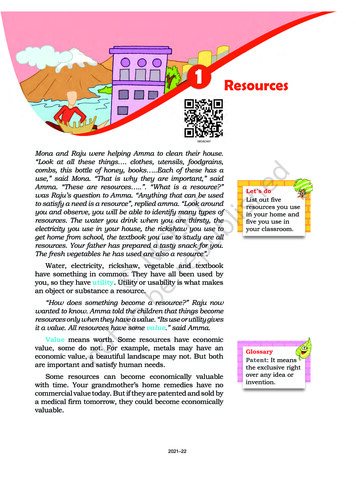
Transcription
Chapter 4Natural Resources andEnvironmental ConstraintsPERSONAL VISION STATEMENTS“I want to live in a city thatcares about air quality and theenvironment.”“Keep Birmingham beautiful,especially the water ways.”4.1
CITY OF BIRMINGHAM COMPREHENSIVE PLANPART II CHAPTER 4 NATURAL RESOURCES AND ENVIRONMENTAL CONSTRAINTSGOALSPOLICIES FOR DECISION MAKERSnatural areas and conservationA comprehensive green infrastructuresystem provides access to andpreserves natural areas andenvironmentally sensitive areas. Support the creation of an interconnected green infrastructure network that includesnatural areas for passive recreation, stormwater management, and wildlife habitat.Reinvestment in existing communitiesconserves resources and sensitiveenvironments. Consider incentives for reinvestment in existing communities rather than“greenfields,” for new commercial, residential and institutional development. Consider incentives for the conservation and enhancement of natural and urbanforests. Consider incentives for development patterns and site design methods that helpprotect water quality, sensitive environmental features, and wildlife habitat.air and water qualityThe City makes every effort toconsistently meet clean air standards. Support the development of cost-effective multimodal transportation systems thatreduce vehicle emissions. Encourage use of clean fuels and emissions testing. Emphasize recruitment of clean industry. Consider incentives for industries to reduce emissions over time. Promote the use of cost-effective energy efficient design, materials and equipment inexisting and private development.The City makes every effort toconsistently meet clean waterstandards. Encourage the Birmingham Water Works Board to protect water-supply sourceslocated outside of the city to the extent possible. Consider incentives for development that protects the city’s water resources. Consider incentives for the protection of natural drainage in stormwater managementsystems where feasible. Consider incentives for the use of conservation and low-impact developmenttechniques. Support state water quality standards and enforcement. Monitor drilling uses of water resources to avoid contamination or excessive useand use best management practices.Front image: www.aothemagazine.com/?p 384.2
CITY OF BIRMINGHAM COMPREHENSIVE PLANPART II CHAPTER 4 NATURAL RESOURCES AND ENVIRONMENTAL CONSTRAINTSfindingschallengesRed Mountain Park and Ruffner Mountain Nature Preserveare significant natural areas that provide access to natureand environmental services (such as reduction in urbanheat island effects, air pollution, and nonpoint source pollution of water) in an otherwise urban environment.Reducing vehicle emissions through increased transit usewill require regional partnerships/cooperation.The city has had success in flood mitigation throughflood buyouts along Village, Valley and Shades Creeksin conjunction with FEMA, Corps of Engineers and stateagencies and continued flood mitigation planning.With the exception of engineering design standards forstreets, the only regulations for steep slopes are thosethat require geotechnical engineers’ affidavits for construction on parts of the north face of Red Mountain.Segments of the Cahaba River, Valley Creek, VillageCreek, Shades Creek and Camp Branch Creek exceed TotalMaximum Daily Load allowances for various pollutants.Increased walking and bicycling can help reduce vehicleemissions, but extensive improvements are needed inbicycle and pedestrian infrastructure to support thesealternative travel modes.Many sources of air pollution are not located in the city orsubject to City control.Threats to Birmingham’s water quality are not all locatedin the city or subject to City influence.The potential development of land in the Cahaba areaposes risks to the Cahaba River, a drinking-water source.Most of this land is outside the city limits.Water quality monitoring is performed by the City’sStormwater Management Division.Birmingham does not consistently meet EPA ozonestandards, which reflects impacts on public health dueto air pollution, and constrains industrial expansion andrecruitment and federal transportation funding.There are numerous local and regional private organizations involved in parks development, open space preservation and environmental stewardship.Almost all of the land in the city limits that is adjacent toor near the Cahaba River, Little Cahaba River, and LakePurdy is owned by the Birmingham Water Works Board toprotect water supply resources.Quality of life, which includes environmental quality, is anincreasingly important criterion in private sector economicinvestment decisions.4.3
CITY OF BIRMINGHAM COMPREHENSIVE PLANPART II CHAPTER 4 NATURAL RESOURCES AND ENVIRONMENTAL CONSTRAINTSA. What theCommunity SaidFrom the outset of this plan’s community involvementprocess, participants have held up the city’s naturalenvironment and green infrastructure as vital parts of thecity.Attendees at the various forums ranked Birmingham’sparks, landscape and topography as its best asset, receivingtwice as many votes as any other category. Participants alsoindicated that pollution, clean air and other environmentalissues were among the city’s top challenges. Among the“Top Five Priorities” from table discussions, walking/bikingroutes and parks, beautification and addressing pollutionwere all noted.During the Communities of Interest workshop on GreenSystems and Sustainability, attendees identified issuesthat brought them to the meeting and table discussionsprovided a set of priorities. Several of those dealt with theenvironmental concerns addressed in this chapter.Issues Water quality and stormwater managementAir qualityInterconnected green infrastructure networkGreen the city, more treesSprawlUsing the city’s green amenities to attract investmentPriorities 4.4Improve air qualityImprove water qualityProtect biodiversity and wildlife habitatIncrease public awareness on green systems andsustainabilityPromote alternative, clean energy sourcesProtect and increase citywide tree canopyClean up and re-use brownfieldsBuild greenways with destinationsTCI Ensleyworks is the one of the largest brownfields in theBirmingham area.B. Topography,Geology andLandscape CharacterSince its early history Birmingham capitalized easilyon its natural assets but struggled with their long-termstewardship. Birmingham’s geology offered tremendouseconomic opportunity during the industrial boom ofthe late 1800s. The three main components of iron andsteel production—coal, iron ore and limestone—werereadily available from Jones Valley, which also provided aconvenient landscape for settlement. Railroad, mining andiron production facilities exploded across the landscapeand Birmingham grew rapidly and densely.Of its major topographic features, the city is most closelyassociated with Red Mountain, which rises to just over1,000 feet above sea level—about 400 feet above downtownBirmingham directly to the north. Shades Mountain,further to the south, is the tallest formation in Birmingham,peaking at about 1,150 feet above sea level.
CITY OF BIRMINGHAM COMPREHENSIVE PLANPART II CHAPTER 4 NATURAL RESOURCES AND ENVIRONMENTAL CONSTRAINTSThe city developed along the relatively flat Jones Valleybetween Red and Sand mountains. This provided a logicalpath for the railroads that were laid through the middle ofthe valley. As communities took shape along the railroad,the mountains limited development to the north and south.Birmingham grew as a dense urban grid that diminishedas it extended toward the neighboring ridges, particularlythe steeper and more challenging Red Mountain. Urbanvillages developed further east and west along the valleyincluding areas like Woodlawn and East Lake, Bessemerand Ensley.Today, mining and manufacturing remain but represent amuch smaller part of Birmingham’s economy. Its readilyharvestable geologic resources have been greatly depleted.Vacant mines and foundries dot the landscape. But theseremnants of the area’s industrial heritage are seeing asecond life as regional parks (Ruffner Mountain NatureCenter, Red Mountain Park and Vulcan Park), greenways,and historic landmarks (Sloss Furnaces). However, there iscontinued mining northwest and west of the city along theMulberry Fork of the Black Warrior River.HYDROLOGYThe northern and western portions of the city lie within theBlack Warrior-Tombigbee River Basin while the areas southand east of Red Mountain are in the Alabama River Basin.Through each basin numerous tributaries flow and formwatersheds including: Village Creek, Valley Creek, ShadesCreek, Five Mile Creek, and the Cahaba River.StreamsThe early communities of Birmingham were relatively farfrom the Black Warrior and Cahaba Rivers, to the northwestand southeast respectively. But Jones Valley is traversed bythe smaller Village Creek and Valley Creek. Like Red Mountain to the south, Village Creek limited northern expansionearly on. It served as the city’s early water supply until it wastoo contaminated to provide clean water.After decades of development and industrial and otherforms of pollution, efforts by the City, UAB, the grassrootsVillage Creek Society, area residents and others, includingFIGURE 4.1: WATER AND WATERSHEDS4.5
CITY OF BIRMINGHAM COMPREHENSIVE PLANPART II CHAPTER 4 NATURAL RESOURCES AND ENVIRONMENTAL CONSTRAINTSthe construction of a Jefferson County peak-flow treatmentfacility that began operation in 2003, have greatly improvedits water quality. The state designates the creek a LimitedWarmwater Fishery, the second-lowest of seven water-usedesignations. The creek is listed as impaired for pathogensand pesticides.Village Creek has also been the site of destructive floods.Due in part to urbanized development with concentrationsof impervious surfaces, repetitive property losses led theCity, in cooperation with the US Army Corps of Engineers(USACE) and FEMA to carry out multiple mitigationprograms between 1983 and 2000. The USACE and FEMAtout the Village Creek program as a successful case study inflood-mitigation practices, citing a significant return on theinvestment of 36 million by avoiding continued propertylosses estimated at 60 million.1 With the acquisition ofland through flood-mitigation efforts and ongoing cleanup activities, the Freshwater Land Trust’s Champions forVillage Creek Greenway are working with the City, theSouthern Environmental Center and the Jefferson CountyDepartment of Health to construct a major greenway trailand park system along the creek.A 0.9 mile stretch of Valley Creek, which flows throughsouthwest Birmingham to Bankhead Lake, an impoundmentof the Black Warrior River, has been listed as impaired bythe Alabama Department of Environmental Management(ADEM) due to atmospheric deposition, which contributesto the presence of mercury in the water. Its tributary to thesouth, Opossum Creek is similarly impaired.2000s, the Five Mile Creek Partnership was formed withsupport from Cawaco RC&D and area municipalities. ThePartnership has prepared plans for and is using floodacquired land to construct parks and trails along the creekcorridor.Cahaba RiverThe longest free-flowing river in the state, the Cahaba Riveris nationally recognized for its biodiversity, including beinghome to several endangered animal species, numerousplant species and eighteen species of fish found nowhereelse in the world.The Black Warrior Cahaba River Land Trust was fundedby the County as part of the consent agreement with theEPA over pollution mitigation. Today it is known as theFreshwater Land Trust. Since its creation, the land trust hasacquired a total of 4,500 acres along multiple waterwaysand in other strategic locations, 4,300 acres in fee and200 acres in conservation easements. Creation of the landtrust produced benefits to the region that were unforeseenat the time—establishment of Red Mountain Park andpreparation of the countywide Red Rock Ridge and ValleyTrails Master Plan.In 2003 a consortium of local governments oversaw thedevelopment of the Upper Cahaba Watershed Study. Theplan has raised public awareness of potential water qualityand other environmental issues.Shades Creek flows southwesterly through the city intothe Cahaba River. Because water-quality measurementsdid not support its use designation for Fish & Wildlife,Shades Creek has been placed on the state’s list of impairedwaterways. Repetitive-flood-loss property along ShadesCreek was acquired through a FEMA-funded mitigationproject in 2000. A greenway and multi-use trail have beendeveloped along the creek near Lakeshore Parkway in theHomewood and Mountain Brook area.Five Mile Creek, a tributary of the Black Warrior River,flows westward along the northern edge of the city. It isnot listed as impaired. Following flooding in the or-success/00008.pdf4.6Cahaba River near Grants Mill Road (Photo: Encyclopedia ofAlabama, Hunter Nichols)
CITY OF BIRMINGHAM COMPREHENSIVE PLANPART II CHAPTER 4 NATURAL RESOURCES AND ENVIRONMENTAL CONSTRAINTSLakesFloodplainsThe Birmingham Water Works Board built the LakePurdy Dam on the Little Cahaba River in 1929 soon afterVillage Creek became too polluted to serve as a watersupply. The reservoir, near the headwaters of the CahabaRiver, is owned by the Birmingham Water Works Board(BWWB) and encompasses 990 acres. In 2008 the BWWBadopted a policy requiring Board approval for developmentin the Cahaba River watershed to manage possiblepollution in order to protect the water supply. That policyincludes prohibitions on certain contaminating uses andactivities; performance requirements for nonpoint sourcepollutants; and enforcement measures. As a temporarymeasure the City created the Holding Zone District tolimit development in the Lake Purdy/Cahaba River area.This zoning classification was applied to properties in theimmediate vicinity of Lake Purdy, most of which is ownedby the BWWB.Floodplains occur in several areas throughout the cityand are associated with Birmingham’s major streams—Village, Valley, Shades and Five Mile creeks—and theCahaba River. Localized flooding in other low lying areasalso occurs. Urban development along Birmingham areastreams resulted in increased flood elevations during heavyrainfalls. As previously described, the City, with stateand federal support, has acquired a significant numberof properties impacted by past flooding, particularlyalong Village Creek. And, following the County-EPAconsent decree, the Freshwater Land Trust has alsoacquired property and conservation easements within areafloodplains.Bayview Lake was built on Village Creek in 1910 as a watersupply reservoir for coal mining activities and for theEnsley Iron Works. Receiving flow from Village Creek, ittoo became polluted from untreated industrial and sanitarywastewater. After the closing of the Thomas and EnsleyWorks and installation of secondary treatment facilitiesrequired by the Clean Water Act of 1972, water qualityin the lake improved to the extent that it is now used forrecreational purposes.Lake Purdy (Photo: 280 Living, Chris Mason)Floods are of relatively short duration, usually less than tenhours. Maximum flood stage is typically reached within twoto four hours of an intense rainfall event. Past events haveseen flood waters rise at three feet per hour with significantvelocities experienced in some parts of the city. The mostdestructive flooding has occurred along Village Creek,which led to the mitigation and buyout programs alongthat corridor. Area floodplains have historically floodedbut due to the intensive flood events that occurred between1995 and 2003, the City increased efforts to mitigate flooddamage and improve stormwater-management programs.There are three flooding segments typically regulated toprotect against flood damage: The floodway, the floodfringe, and the floodplain. The floodplain is the areadeemed to have a 1% chance of flooding every year (the“100-year” flood). This creates a 26% chance of floodingduring a typical 30-year home mortgage. The floodway isthe area that must be kept clear immediately adjacent to thestream because it functions as the natural conduit for floodFlooding on Tallapoosa Street during Tropical Storm Lee inSeptember 2011 (Photo: Birmingham News, Hal Yeager)4.7
CITY OF BIRMINGHAM COMPREHENSIVE PLANPART II CHAPTER 4 NATURAL RESOURCES AND ENVIRONMENTAL CONSTRAINTSwaters. The flood fringe is an area between the floodwayand the floodplain boundary, where development is allowedas long as it meets certain criteria. The floodplain includesboth the floodway and the flood fringe. The City joined the National Flood Insurance Program(NFIP) in 1981 and the Community Rating System, avoluntary program to establish floodplain managementprograms to exceed NFIP requirements, in 1993.Development within Birmingham’s 100-year floodplainsis controlled through a Flood Plain Ordinance and isreviewed and permitted by floodplain management staffhoused within the Planning, Engineering and Permits (PEP)Department. The ordinance requires residential buildingsbe located above the 100-year base flood elevation and nonresidential buildings must be elevated or flood-proofed.Through its floodplain management efforts, the city is ratedClass 6, which provides a 20% reduction in flood insurancepremiums for property owners.Because Birmingham’s waterways flow through multiplejurisdictions, the City cannot fully protect its waterresources. In addition to the stormwater managementactivities the City performs, it must work in partnershipwith other local governments to meet its water qualityobjectives.Stormwater Management and Water QualityAs described above, the city has historically experiencedchallenges to maintaining water quality in area waterways.However, in the past 20 years, the City intensified its effortsto better manage stormwater and water quality.The City developed its first Phase 1 NPDES (NationalPollutant Discharge Elimination System) MS4 Programapplication in 1992 and then joined a multi-jurisdictionalstormwater program. The City of Birmingham withdrewfrom the most recent version of the multi-jurisdictionalprogram in 2008 to improve program accountability andorganizational coordination, and to lower program costs.Following its withdrawal, the City contracted with a privatefirm to assist city staff in its stormwater-managementprogram.The Birmingham stormwater-management programinvolves preparation and maintenance of a comprehensivestormwater management plan, compliance activities,stormwater monitoring and related functions. Currently,the City manages stormwater and water quality throughseveral program strategies: preventive measures property protection4.8emergency servicesstructural projectsnatural resource protectionpublic education programsDEVELOPMENT CONDITIONS IN BIRMINGHAM’S100-YEAR FLOODPLAINThere are approximately 5,700 parcels, altogether about 5,000acres, located within the city’s 100-year floodplains. Today, about 2,100 acres of that land is owned by the City,county, state and federal governments; the Freshwater LandTrust; Airport Authority; and utility companies. An estimated 4,800 parcels—just over 2,900 acres—areprivately owned. There are over 3,900 residentially-zoned, privately-ownedproperties in the city’s 100-year floodplains. Over 800 ofthose properties are vacant and undeveloped. 230 properties, totaling 186 acres, are zoned for businessor institutional uses and over 60% of those properties aredeveloped. More than half of the privately owned land in the 100-yearfloodplain—about 1,500 acres—is zoned for industrial ormanufacturing use.SOURCE: CITY OF BIRMINGHAM, GIS DATA.AIR QUALITYSimilar to its historical water quality issues, Birminghamis not entirely in control of its air quality. Air quality in thecity is affected by point and nonpoint sources both insideand outside the City’s jurisdiction. A major focus to improveair quality in the region has been and continues to be todecrease vehicle emissions through congestion-mitigationactivities, including consideration of high-occupancyvehicle lanes on major arteries and regional transit systemimprovements. Chapter 12, pp. 12.34–12.42, contains adiscussion of transit and active transportation opportunities.In addition to vehicle emissions and industrial activities,buildings contribute to air quality issues. Burning of fossilfuels, such as coal, oil and gas, and the use of variousbuilding materials and cleaning products affect both
CITY OF BIRMINGHAM COMPREHENSIVE PLANPART II CHAPTER 4 NATURAL RESOURCES AND ENVIRONMENTAL CONSTRAINTSHABITATS AND BIODIVERSITYBirmingham is located within the Ridge and Valleyecoregion and is a geographic transition point that supportssignificant, unique biodiversity, notably on the CahabaRiver and Turkey Creek.CommuteSmart is a ridematching, carpool and vanpool serviceoperated through the Birmingham Metropolitan PlanningOrganization (MPO) to reduce vehicle emissions.indoor and outdoor air quality. The production of energynecessary to operate buildings (lighting, heating, cooling,etc.) is a significant contributor to air quality problemsbut can be managed through better building systemsdesigns to increase energy efficiency. Likewise, aircraftengines produce emissions that affect air quality. Thereforeair quality around airports may be impacted by aircraftengines. Aircraft engine emissions produce nitrogen oxides(NOx), carbon monoxide (CO), oxides of sulfur (SOx),unburned or partially combusted hydrocarbons (alsoknown as volatile organic compounds (VOCs), particulates,and other trace compounds.The Ridge and Valley ecoregion, also referred to as “thefoothills of the Appalachians,” is characterized by ruggedterrain with sandstone ridges and limestone valleys. Treestypical to the region include white, northern red, black,and chestnut oak, and loblolly, shortleaf, and Virginiapine. The region supports several amphibian and reptiles“of Coastal Plain affinity that are not known to occurelsewhere above the Fall Line” according to Alabama’sComprehensive Wildlife Conservation Strategy (CWCS).Significant wildlife in the region includes the SouthernHognose Snake, Coldwater Darter, Goldline Darter, andCoosa Creekshell.2 The Cahaba Lily is found only inAlabama, Georgia, and South Carolina.Alabama’s CWCS was prepared by the state Department ofConservation and Natural Resources under a federallyfunded State Wildlife Grant. According to the CWCS,EPA is adopting emission standards for aircraft gasthe top concern for wildlife in the Cahaba River in theturbine engines that should improve air quality. TheBirmingham area is water quality degradation fromfinal rule contains standards and related provisions thatsedimentation and nutrient enrichment. Water qualitywere previously adopted by International Civil Aviationproblems stem from development in the upper watershedOrganization (ICAO). Specifically, EPA is adopting two new and agricultural and silvicultural practices. These sametiers of more stringent emission standards for oxides ofproblems, plus the presence of abandoned surface minesnitrogen (NOx). Also, FAA is phasing out leaded gas by 2018 threaten species along the Black Warrior River. Alongwhich will help improve air quality and protect airportthe Black Warrior, the areas in most critical need forneighbors from airborne lead.conservation action include the Locust Fork drainagearea—encompassing most of the City of Birmingham—Pollutants in the air also can contribute to poor waterwhere there is a high number of imperiled species. Thequality, adding to the importance of addressing the city’sCWCS recommends implementation of the River Basinair quality. The source of contamination to Valley andManagement Plans and restoration of habitat and streamsOpossum Creeks in Birmingham, both on ADEM’s list ofby ADEM, US Forest Service (USFS), Alabama Forestry303(d) impaired streams, were classified as being due toCommission (AFC), Natural Resources Conservationair quality.Service (NRCS), Clean Water Partnership, localgovernments and other partners.32Alabama Department of Conservation and Natural Resources, “Alabama Comprehensive Wildlife Conservation Strategy”, tline.cfm, p; 28.3Ibid, pp. 151-161.4.9
CITY OF BIRMINGHAM COMPREHENSIVE PLANPART II CHAPTER 4 NATURAL RESOURCES AND ENVIRONMENTAL CONSTRAINTSPhysiographic regions of Alabama. Map by Department ofGeography, University of Alabama4.10
CITY OF BIRMINGHAM COMPREHENSIVE PLANPART II CHAPTER 4 NATURAL RESOURCES AND ENVIRONMENTAL CONSTRAINTSThreatened and Endangered SpeciesIn Jefferson County there are several endangered andthreatened species and plants and animals, some of which,for example, the watercress darter, are known to occurwithin the city. In fact, the watercress darter is believedto occur naturally only in the Jefferson County area. Afew of these rare species are believed to occur naturally inJefferson, Blount and Bibb Counties only.URBAN FORESTThe “urban forest” includes all the trees in and aroundurban areas—street trees and trees on public and privateproperty. The large trees characteristic of Birmingham’searly neighborhoods are an important part of their sense ofplace. However, other parts of the community, particularlyin more recently developed neighborhoods and businessareas, have little tree cover. Planting and maintaining treesin the urban environment has a variety of benefits: improving the public realm and community aesthetics increasing property values providing shade and reduced energy costs enhancing walkability enhanced flood mitigation preserving wildlife habitat reduction in greenhouse gas pollution (CO2) oxygen productionAccording to the 2004 study “State of the Forest in theCities of Jefferson County” carried out by the JeffersonCounty SWMA, the urban forests of the Birmingham metroarea, including portions of the Cahaba River watershedin Shelby and St. Clair Counties, provided 248 millionannually in air pollution and stormwater reduction. Thereport suggested that the presence of trees, and thereforethe ground in which they are planted, allow stormwaterto be absorbed into the ground while impervious parkingareas, rooftops, and roadways funnel stormwater morerapidly to area streams. The stormwater monetary savingswere based on the cost that would be required for detentionponds and other stormwater controls that would otherwisebe required in the absence of such forested areas. 44Birmingham Environmental News #212, “Tree Study: Trees Worth 248 Million aYear in Birmingham Metro,” ’s Five Points South neighborhood has a healthyurban tree canopy (Photo: Robert Francis)The City has an adopted tree ordinance (Ordinance No.90-88). but the City has drafted an ordinance that wouldreplace or amend existing policies and standards forthe preservation of the city’s tree canopy, particularlytrees within public rights-of-way and easements. Theordinance establishes a Tree Commission to guide thedevelopment and administration of future policies andrecommendations; specifies standards for tree plantingand maintenance; establishes management authority fortree planting, removal and maintenance under the City’sUrban Forester and those concerned with public safety; andpromotes public education on the importance and valueof urban forests. The draft amended ordinance is underinternal review as of summer 2013.Invasive PlantsInvasive plant species are typically non-native andproliferate in hospitable environments. In thesecircumstances they can out-compete native plants anddisrupt ecosystems. Among those that are of particularconcern in the Birmingham area are privet and kudzu.Other invasive plants in the area include heavenly bamboo,English ivy, Oregon grape/Beale’s barberry, Japanesehoneysuckle, mimosa, Amur honeysuckle, Bradford pear,and leatherleaf mahonia.4.11
CITY OF BIRMINGHAM COMPREHENSIVE PLANPART II CHAPTER 4 NATURAL RESOURCES AND ENVIRONMENTAL CONSTRAINTSTABLE 4.1: ENDANGERED AND THREATENED SPECIES OF JEFFERSON COUNTY, ALABAMASPECIESNAMESTATUSAMPHIBIANSBlack warrior waterdogOrangenacre mucketSouthern acornshellUpland combshellFinelined pocketbookOvate clubshellTriangular kidneyshellAlabama moccasinshellDark pigtoeSouthern pigtoeWatercress darter*Cahaba shinerGoldline darterVermilion darter**Rush darterGeorgia rockcressMohr’s Barbara buttonGentian pinkrootTennessee yellow-eyed grassGeorgia asterIndiana batGray batFlattened musk turtleCylindrical lioplax***Plicate rocksnail**Round ndangeredThreatenedCLAMSFISHESFLOWERING PLANTSMAMMALSREPTILESSNAILS* Known to or believed to occur only in Jefferson County.** Known to or believed to occur only in Jefferson and Blount counties.*** Known to or believed to occur only in Jefferson, Blount and Bibb counties.SOURCE: US FISH & WILDLIFE SERVICE ENVIRONMENTAL CONSERVATION ONLINE SYSTEMAbove: Coldwater Darter, Etheostoma ditrema (Photo: OutdoorAlabama). The Cahaba Lily (left) is found only in Alabama,Georgia and South Carolina. One of the two largest remainingstands of the plant is in the Cahaba River National WildlifeRefuge in West Blocton.4.12
CITY OF BIRMINGHAM COMPREHENSIVE PLANPART II CHAPTER 4 NATURAL RESOURCES AND ENVIRONMENTAL CONSTRAINTSCONSERVATION AND ENVIRONMENTALORGANIZATIONSNumerous nonprofit organizations and initiativesare working to improve conservation of sensitiveenvironmental areas and restore environmental health bothlocally and throughout the region.Alabama Clean Fuels Coalition is an affiliation of businesses,governmental and utilities repre
4.1 Chapter 4 Natural Resources and Environmental Constraints "I want to live in a city that cares about air quality and the environment." "Keep Birmingham beautiful,











